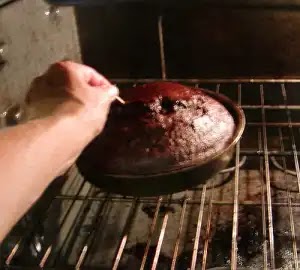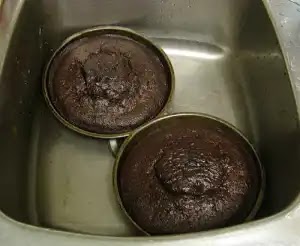This is the best chocolate cake you will ever eat! It is truly moist, dense and delicious and it is so easy to make from scratch! When I was growing up my mother’s best friend was a baker. This was her recipe.
1 3/4 cups flour
2 cups sugar
3/4 cups cocoa
1 teasp salt
2 teasp baking soda
1 teasp baking powder
2 eggs
1 cup buttermilk or 1 tablesp vinegar in 1 cup of warm milk, soured
1/2 cup oil
1 teasp vanilla
1 cup coffee, plain or flavoured.
I like to use flavoured coffee in this cake and also in the frosting. Usually I use hazelnut vanilla but for this one I used butterscotch coffee, because that is what I had on hand.
Combine all dry ingredients in a large bowl. Add remaining ingredients. Beat with mixer for 2 mins. Pour into two round greased and floured pans or one greased and floured rectangular pan.
The batter will be very runny, but that’s as it should be.
Bake at 350 degrees for 35-40 minutes, just until a toothpick inserted in the center of the cake comes out dry. Do not over bake and make sure it is done!! This will require you to watch the cake carefully for the last few minutes of baking time, occasionally testing it until it is perfect. The key to a truely fabulous cake is to take it out of the oven at exactly the right moment.
Make certain that your oven is calibrated properly. Most electric ovens get hotter over time so that they are baking at about 375F when you put the dial on 350F.
If you are mechanically inclined you can fool around with the thermostat inside the oven and adjust it in the right direction a tiny bit. We do this when we get another oven or when our oven is obviously too hot. You will need a good digital or oven thermometer to do this and it takes time. Adjust the thermostat in the oven a tiny bit, then turn the oven on until the light goes out. Use the thermometer to test the temperature in the oven when the light goes off, adjusting the oven thermostat slightly, over and over again until you get it exactly right. It could take an entire day to calibrate your oven, but its worth it! It makes a huge difference in baking to have the oven at the right temperature. It should be a few years before it needs it again.
Please don’t ask me for exact details. All ovens are different. Hubby does this and I don’t know exactly how he does it. You can probably find out on the ‘net’.
If you know that your oven bakes hot, you can always just turn it down a smidgen. If you turn it down too far and it is baking too cool, the cake will take longer and dry out before it gets done, so be careful with that. If it bakes too hot the cake will be overdone on the outside before it gets done on the inside.
Also, if you are using a glass dish you should bake at a slightly lower temperature.
When the cake is done and removed from the oven it should cool to room temperature before frosting. I set my pans in very cold water in the sink to cool them quickly. Never, ever frost a cake that is even slightly warm. The frosting melts! You can make a fabulous cake and come back an hour later to find the second layer sliding off and sitting beside the bottom one and the frosting all pooling in the plate! (I found this out the hard way!)
When the cake has cooled completely it is ready to be frosted.
This is how I make frosting. I never use a recipe for it.
Put about 3.5 cups of powdered icing sugar in a large bowl. If making chocolate frosting, put about 1 cup of dry cocoa in with the sugar. Dont use an instant pudding mix in here to make flavoured frosting. It doesn’t dissolve. Jello that has been made and set might work well but I haven’t tried it yet.
Add about a tablespoon of vanilla or other flavour extract unless using cocoa, then you won’t need it, unless you want to add a specific flavour to chocolate frosting, like cherry. You can be creative here.
Add about this much butter.
Mix it slowly on low until the butter has been fairly evenly cut into the sugar and you have a dry, lumpy mix. Then add liquid very slowly, a tablespoon or so at a time until the frosting is the right texture. Beat it on high for a few minutes.
You can use any liquid. I use coffee to make the frosting for this cake. The same coffee that I put in the cake. The flavoured coffee makes especially good frosting.
I sometimes make an orange cake, using fresh orange juice to make a white cake and using fresh orange juice to make the frosting. Carrot juice in the frosting for a carrot cake?
If you put too much liquid in the frosting, just add a bit more sugar and mix again. Add only a tiny amount of sugar or liquid at a time until the frosting is the right texture. Aim for a little too stiff as opposed to a little too soft. The frosted cake will hold together better with a stiffer frosting but it will slide if the frosting is too soft.
If you made a layer cake you will need to cut the top off of the bottom layer, making it flat. Otherwise the finished cake will be slanted.
After cutting off the top of the bottom layer, spread frosting on it carefully. You don’t want to tear up the cake without a top on it to protect it. Set the other layer on top of this frosted one and continue to frost the top and sides of the cake.
I like to drizzle some melted hard chocolate on the top of a chocolate cake and sometimes other cakes, as well. I buy chocolate Easter bunnies on sale after Easter, chop them and put them in the freezer for this purpose. If they are chopped up and frozen other people don’t eat them.
When I am making the frosting I melt about 1/3 of a bunny (You will have to use your judgement here) in a glass measuring cup that I have put in a small pot of water on the stove. I add a few drops of oil to it while it is melting to make it smooth. You will also need to stir it a lot and watch it carefully. As soon as it melts, turn the heat off.
When the cake is frosted you can drizzle the chocolate in lines across the top or dot it on. You can also make chocolate leaves with it. If you are going to make chocolate leaves, don’t put much oil in the chocolate while it is melting. You want it to get really hard when it cools.
To make chocolate leaves you will need some clean leaves from the garden to use as a mold. Paint the melted chocolate onto the leaf tops and let them cool until they get hard. Peel the leaf off the bottom. This should leave you with a chocolate leaf you can arrange on the top of the cake. I don’t usually have the time to do this.
This cake is especially good with handmade, chemical free black cherry wine! You can even use this in the cake instead of coffee. You can put it in the frosting too, if no children are eating it. The frosting doesn’t get heated so all the alcohol will remain in the frosting to be eaten. (Warn people before they eat it!)
If you keep an apple in the container with a cake, it will help to keep it moist.
Its not a miracle worker, however. If you don’t keep the cake well sealed, it will still dry out.
Most cakes freeze well, too, if sealed properly. Freeze half of it if you don’t think it will be eaten in a week.

































